You can elevate your outdoor cooking experience with the art of rotisserie grilling. This method not only infuses your meats with incredible flavor but also ensures an even, succulent cook that can’t be matched by traditional grilling. In this step-by-step guide, you will learn everything you need to know, from choosing the right equipment to mastering the perfect seasoning. Whether you’re a novice or looking to sharpen your skills, this guide will help you become a rotisserie grilling expert, impressing your family and friends with mouth-watering results.
Key Takeaways:
- Preparation: Properly prepare your rotisserie by selecting the right size and type of meat, marinating it for enhanced flavor, and ensuring it’s balanced on the skewer for even cooking.
- Temperature Control: Maintain consistent heat throughout the cooking process, typically between 350°F and 375°F, to achieve a perfectly cooked, juicy, and golden-brown exterior.
- Cooking Time: Be mindful of cooking times based on the size and type of meat, using a meat thermometer to check for doneness, ensuring that safety standards are met while optimizing taste and texture.
Types of Rotisserie Grills
The world of rotisserie grilling is diverse, featuring various types of grills that cater to different preferences and needs. Each type has its unique characteristics and benefits, making it crucial for you to understand the options available. Below is a breakdown of the main types of rotisserie grills:
| Type | Description |
|---|---|
| Charcoal Rotisserie Grills | Grills that use charcoal as the primary heat source, offering a natural smoky flavor. |
| Gas Rotisserie Grills | Grills that are powered by propane or natural gas, allowing for quick temperature adjustments. |
| Electric Rotisserie Grills | Grills that run on electricity, suitable for indoor use and easy to operate. |
| Oven Rotisserie Attachments | Attachments designed to convert your standard oven into a rotisserie, offering versatility. |
| Portable Rotisserie Grills | Compact grills designed for easy transport, perfect for camping or tailgating. |
After reviewing these options, you’ll be better equipped to select the ideal rotisserie grill for your cooking style.
Charcoal Rotisserie Grills
While charcoal rotisserie grills are known for their traditional approach to grilling, they bring a unique flavor to your food that many enthusiasts crave. The use of charcoal as a heat source allows for excellent temperature control, which is vital for slow-cooked meats to achieve that juicy tenderness. When you use a charcoal rotisserie, you can infuse your meat with a rich, smoky flavor that gas or electric grills simply cannot replicate.
Moreover, these grills generally come at a lower price point compared to gas and electric models. Thus, for those who enjoy the process of preparing their fuel and the satisfaction that comes with using natural ingredients, charcoal rotisserie grills are an excellent choice. It’s important to practice safety measures, ensuring you achieve optimal grilling conditions for delicious results.
Gas Rotisserie Grills
Grills that utilize gas are a convenient option for rotisserie cooking, primarily due to their ability to heat up quickly and maintain consistent temperatures. This means you can spend less time waiting and more time enjoying your perfectly cooked dishes. Gas rotisserie grills are equipped with burners, which allow for precise temperature control, making them a favorite among busy home cooks.
Additionally, gas rotisserie grills usually feature larger cooking areas, allowing you to roast multiple items simultaneously. This feature is particularly useful for gatherings where you aim to impress your friends and family with mouthwatering meals. Connecting your grill to a gas line or using a propane tank also eliminates the hassle of dealing with charcoal, offering a more straightforward cooking experience.
A major advantage of gas rotisserie grills is their ease of use. You can start cooking with just a simple twist of a knob, making them incredibly user-friendly, especially for beginners in the rotisserie grilling world. This flexibility allows you to experiment with various marinades and seasonings while ensuring a high level of consistency.
Electric Rotisserie Grills
Any electric rotisserie grill offers an appealing solution if you’re limited on outdoor space or live in an area with restricted outdoor cooking. These models make it easy to roast your favorite meats indoors, providing you with convenience without sacrificing flavor. The temperature settings are simple to adjust, so you can experiment with different cooking times and methods without much hassle.
Additionally, electric rotisserie grills often include built-in timers and temperature gauges, assisting you in achieving perfectly cooked meals with minimal effort. Their compact design makes them easy to store when not in use, which is an added benefit for those with limited kitchen space.
Charcoal rotisserie grills often have a reputation for producing superior flavors, particularly when it comes to smoked meats. However, electric models have improved significantly over the years, offering robust performance that might surprise you. If you’re willing to explore electric options, you might find that you can achieve delightful results with less fuss.
Oven Rotisserie Attachments
Charcoal rotisserie attachments transform your conventional oven into a rotisserie cooking machine. This option is ideal for those who may not have the outdoor space for a standalone grill but still wish to enjoy juicy, evenly roasted meats at home. The versatility of oven attachments allows you to experiment with rotisserie cooking without needing to invest in an entirely new grill.
Using oven rotisserie attachments can also save energy compared to turning on your entire oven. Furthermore, they enable you to leverage your existing oven capabilities while gaining the benefits of rotisserie cooking techniques.
The beauty of oven rotisserie attachments lies in their ability to provide convenience and flexibility in your cooking space. They are perfect for those who love experimenting with various cooking methods while keeping things simple and efficient.
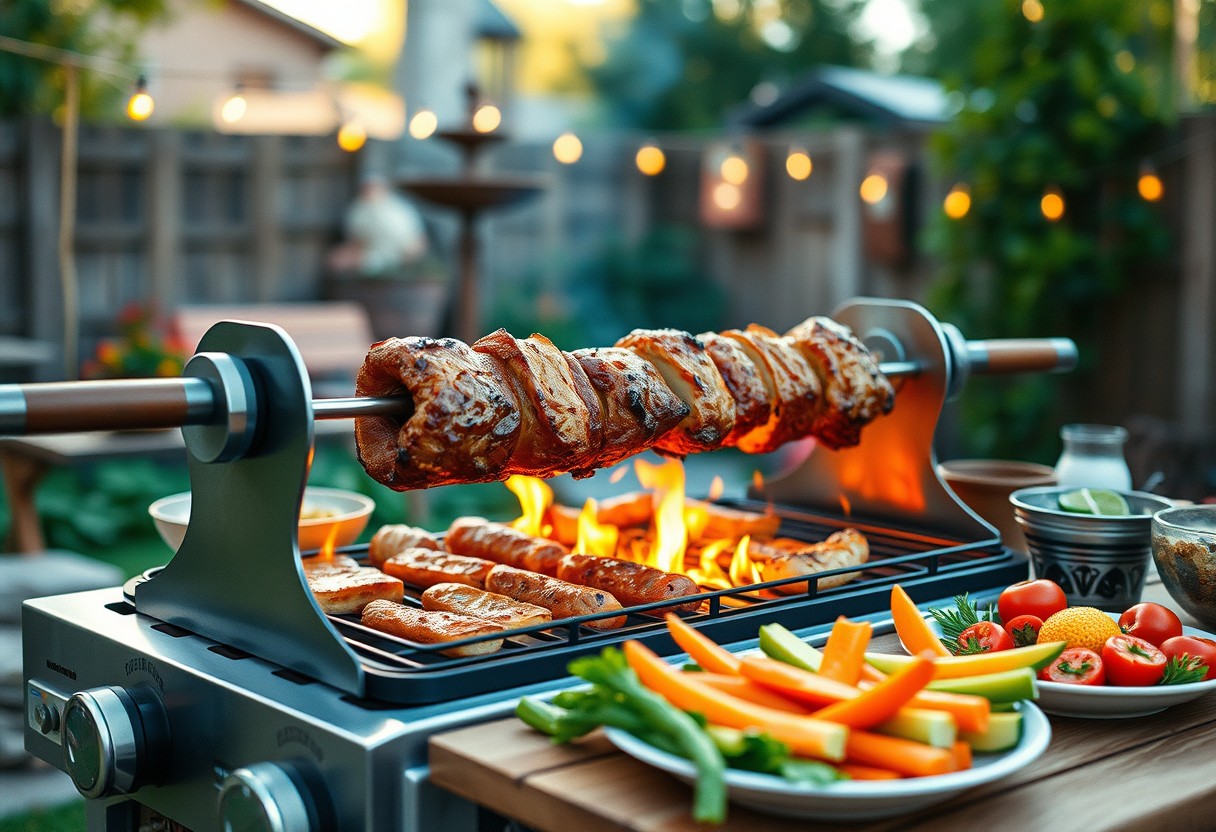
Factors to Consider When Choosing a Rotisserie Grill
If you are looking to elevate your grilling game, choosing the right rotisserie grill is important. There are several factors to consider before making a purchase that will ensure your grilling experience is both enjoyable and successful. Here are some key points to keep in mind:
- Size and Capacity
- Fuel Source
- Temperature Control
- Build Quality and Materials
Size and Capacity
Consider the size and capacity of the rotisserie grill, as it directly impacts the types and quantity of food you can cook at once. Rotisserie grills come in a range of sizes, accommodating everything from small chickens to large cuts of meat. Depending on your typical grilling needs, ensure that the grill can handle the size of the meals you intend to prepare. One key consideration is whether the grill can accommodate food for gatherings or family dinners without overcrowding.
Additionally, think about your available cooking space. A larger grill offers more cooking capacity but requires more space in your backyard or on your patio. Assess your outdoor area to find a rotisserie grill size that fits seamlessly into your setup without compromising convenience or aesthetics. Assume that a well-planned layout will enhance your grilling experience.
Fuel Source
Fuel plays a crucial role in your rotisserie grilling experience. You generally have three options: charcoal, gas, or electric. Each fuel source provides unique benefits, and your choice will depend on your cooking preferences and lifestyle. Charcoal grills give you that classic smoky flavor, while gas grills allow for quicker startup and temperature adjustments. Electric grills, on the other hand, often come with precise temperature controls and minimal cleanup.
Choosing your fuel source also affects the learning curve associated with using the grill. For instance, charcoal requires more practice to master heat control, while gas grills typically offer easier temperature management for beginners. Ultimately, selecting the right fuel source can enhance the flavor of your food and the convenience of your cooking process.
Source of Fuel
| Fuel Type | Advantages |
|---|---|
| Charcoal | Rich flavor, great heat retention |
| Gas | Convenient, quick startup, easy temperature control |
| Electric | Precise temperature control, minimal cleanup |
Temperature Control
For any rotisserie grill, temperature control is paramount for achieving perfectly roasted meats. You want to ensure that your grill allows for horizontal heat management, which is crucial when you’re rotisserie cooking. Look for options that feature adjustable burners or specific settings for rotisserie cooking, as this will enable you to create the right environment for the type of food you are preparing.
Temperature Control Options
| Control Type | Benefits |
|---|---|
| Analog | Simple operation, cost-effective |
| Digital | Precise settings, easy monitoring |
Size and type of the grill will also influence your temperature control capabilities. Larger grills may struggle to maintain consistent heat levels, especially if they’re poorly insulated. You might find models with thicker walls provide better heat retention and distribution, which is critical for successful rotisserie cooking.
Build Quality and Materials
Some people overlook the importance of build quality and the materials used in a rotisserie grill. A well-constructed grill signifies durability and longevity. Look for options that feature heavy-duty stainless steel or cast aluminum, as these materials not only withstand high temperatures but also resist rust and corrosion over time. Ensuring the rotisserie mechanism is sturdy is also important, as this will directly affect the grill’s performance and the evenness of your cooking.
An investment in high-quality materials may cost more upfront but can pay off through increased longevity and superior cooking results. Make sure to check for warranty options as well, which can offer additional peace of mind regarding the build quality of your grill.
Rotisserie grilling can transform your backyard cooking and impress your guests with succulent, evenly cooked meals. Prioritizing these factors—size, fuel source, temperature control, and build quality—will lead you to a rotisserie grill that meets your specific needs and enhances your outdoor culinary adventures.
Step-by-Step Guide to Rotisserie Grilling
After gathering your imperatives and setting your grilling area, it’s time to look into the step-by-step process of rotisserie grilling. This wonderful cooking method not only enhances the flavor but also guarantees even cooking for your meats. Follow along as we break down this process into manageable steps.
Preparing the Grill
| Step | Action |
| 1 | Clean the grill grates thoroughly to ensure no old flavors interfere with your meal. |
| 2 | Prepare your rotisserie setup and make sure it’s in good condition. |
| 3 | Light the grill and preheat it to the recommended temperature for your specific type of meat. |
Preparing the Grill
Now that you’re excited to start cooking, the first crucial step is to prepare your grill. This involves cleaning the grates and ensuring that the rotisserie mechanism works smoothly. A clean grilling surface is imperative for optimal flavor and prevents any sticking during the cooking process.
Additionally, you need to preheat your grill to the appropriate temperature. For most meats, this means setting your grill to a medium-high heat, typically around 350°F to 450°F (175°C to 230°C). This will promote even cooking while developing a nice crust on the outside.
Selecting the Right Cut of Meat
StepbyStep, choosing the perfect cut of meat makes all the difference in achieving delicious results with rotisserie grilling. Consider cuts that will evenly cook on a spit, such as whole chickens, pork loin, or beef roasts. Generally, larger cuts of meat are preferred as they fit the rotisserie apparatus more seamlessly and allow for better flavor retention during cooking.
Additionally, think about marbling and fat content; cuts with a good amount of fat tend to baste themselves during the cooking process, ensuring juicy results. Take time to consider your options and pick a cut that suits your taste preferences and the occasion.
For instance, rotisserie chicken is a popular choice because the continuous rotation allows rendered fat to glaze the skin, enhancing flavor and crunchiness. Meanwhile, a whole pork loin can be equally delightful, as the slow cooking breaks down tougher fibers, resulting in tender meat.
Marinating and Seasoning
Now that you have your cut of meat chosen, the next important step is marinating and seasoning. Marinating your meat enhances its flavor and tenderizes tougher cuts. A simple marinade can be made from olive oil, vinegar, herbs, and your favorite spices. Aim to let the meat soak in the marinade for several hours, or ideally overnight, for maximum flavor integration.
In addition to marinating, don’t forget about seasoning. Generously apply rubs or spices that you enjoy. This creates a flavorful crust as your meat cooks on the rotisserie, adding layers to the overall taste experience.
Guide your choices by experimenting with various marinades and spices that complement your selected meat. Different flavors can elevate a basic rotisserie dish into something truly extraordinary.
Setting Up the Rotisserie
To successfully set up your rotisserie, make sure to attach your meat securely to the spit rod. Properly balance your meat; an unbalanced load can lead to uneven cooking. Depending on the cut, you might need to use hooks or twine to secure it firmly. Make sure the rotisserie motor is functioning well and that your setup is properly aligned with the heat source.
After attaching your meat to the skewer, double-check that it rotates freely without any obstruction. This is vital for cooking the meat evenly, allowing all sides to brown beautifully.
Plus, ensure the distance from the heat source is appropriate. Too close to the flame can result in burnt exteriors while leaving the insides raw. Adjust the elevation of the spit if your grill permits, so your meat receives an even distribution of heat.
Monitoring Cooking Time
Little by little, you will need to monitor the cooking time of your rotisserie meat closely. Typically, larger cuts take longer to cook, while smaller items can be ready faster than expected. As a rule of thumb, consider cooking your meat for about 20 minutes per pound, but always use a meat thermometer to check the doneness.
Plan on checking the meat periodically during cooking to ensure it’s progressing as expected. You can also manually rotate the spit a bit if your grill allows it to ensure all sides are evenly exposed to heat. Doing so may help achieve that perfect golden crust.
Rotisserie cooking not only requires patience but also attentiveness to the cooking process. Set a timer or keep an eye on the clock to make sure you are aware of when you should start checking the temperature.
Ensuring Proper Internal Temperature
While monitoring is key, ensuring that your meat reaches the proper internal temperature is paramount for food safety and achieving flavorful results. Below is a table with common meats and their ideal internal temperatures:
| Type of Meat | Internal Temperature |
| Chicken (whole) | 165°F (75°C) |
| Pork | 145°F (63°C) |
| Beef (medium-rare) | 135°F (57°C) |
Monitoring the internal temperature will help confirm that your meat is cooked sufficiently while also retaining moisture and flavor. Use a meat thermometer for accuracy, and always check the thickest part of the meat without touching the bone, as bone can conduct heat.
Monitoring your results and keeping an eye on the internal temperature is vital. Use an instant-read thermometer for quick checks throughout the cooking process to ensure you’re on track for delicious, juicy results!
Resting the Meat
If you want the best flavor and juiciness, resting the meat after cooking is an imperative final step. Once your meat reads correctly on the thermometer, remove it from the rotisserie and let it rest for about 10 to 15 minutes. This helps the juices redistribute throughout the meat, resulting in a more flavorful bite.
Cover the meat lightly with aluminum foil to keep it warm while it rests. This process also allows the exterior to maintain its delicious crispiness without overcooking the meat.
Meat that has rested retains more moisture during cutting, which brings forth even more flavor. Furthermore, this is a great time to prepare your side dishes or finalize your grill setup for serving.
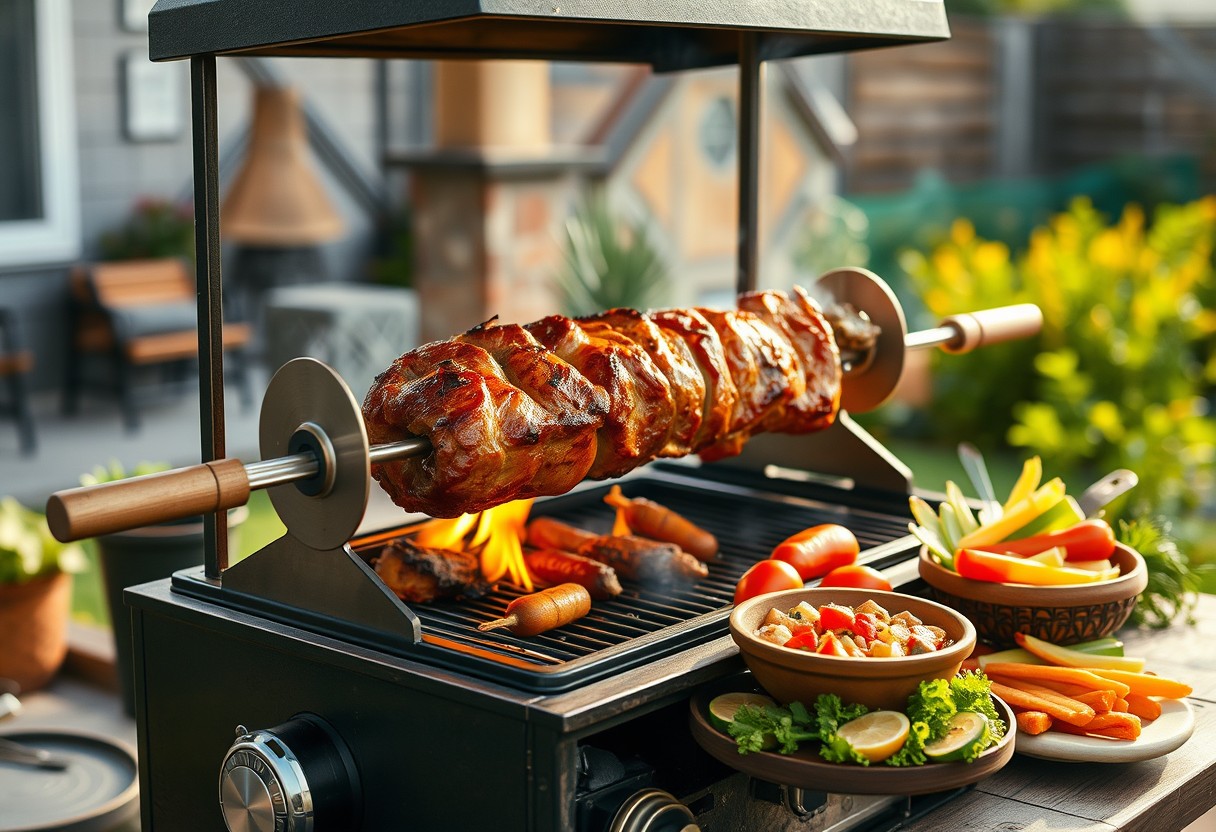
Tips for Perfect Rotisserie Grilling
To achieve perfection in rotisserie grilling, there are several tips and techniques you should keep in mind. Maintaining optimal temperature, ensuring even cooking, and adding flavor are critical components to elevate your grilling experience. Here’s a quick list of crucial tips:
- Always preheat your rotisserie grill.
- Secure your meat properly to prevent uneven rotisserie motion.
- Use indirect heat for slow and even cooking.
- Allow your meat to rest before slicing for juiciness.
- Experiment with different herbs and spices for flavor.
Recognizing these simple yet effective strategies will help you master the art of rotisserie grilling and impress your family and friends. Now let’s probe more specific techniques for your grilling journey!
Using a Meat Thermometer
Some of the most important insights into rotisserie grilling involve understanding how to use a meat thermometer effectively. This tool not only ensures that your meat is safely cooked to the right internal temperature but also helps retain moisture, giving you that succulent finish. As you grill, make sure to insert the thermometer into the thickest part of the meat, avoiding any bones, which can affect accuracy.
By regularly checking the temperature, you can avoid overcooking or undercooking your meat. Ideal temperatures vary based on the type of meat you’re preparing. For instance, poultry should reach an internal temperature of 165°F, while beef, lamb, and pork can be safely consumed at 145°F. Keeping these temperatures in mind prevents foodborne illness and results in perfectly cooked meals.
Basting Techniques
Tips for basting while grilling can drastically enhance the flavor of your meat. Including a basting process in your rotisserie routine can help lock in moisture and add delicious depth to your dish. You can use a simple brush or a spray bottle to apply your choice of marinade or baste; just remember to do so periodically throughout the cooking process for the best results.
Basting not only seals in juices but also allows aromatics from your chosen flavorings to develop beautifully on the surface of the meat. A good rule of thumb is to baste every 20-30 minutes, especially if you’re roasting large cuts. Use a basting sauce that complements the natural flavors of your meat, be it a tangy herb-infused oil or a sweet glaze.
Basting with flavor-infused liquids can transform the finished product, creating a shiny crust that’s rich in flavor. Consider using ingredients like apple cider vinegar, citrus juices, or an array of spices to build layers of taste. You can even combine various liquors in a marinade to create a unique flavor profile!
Flavor Pairing Suggestions
Tips for flavor pairing are crucial for achieving mouthwatering results in your rotisserie creations. The right herbs and spices can accentuate the natural flavors of your meat, leading to a memorable dish. Classic pairings include rosemary and lemon for chicken, or garlic and thyme for lamb. Don’t be afraid to experiment with unique combinations that resonate with your palate.
Moreover, considering regional flavor profiles can give your rotisserie grilling a thematic approach. If you are preparing a Mediterranean dish, incorporate spices like oregano, paprika, and tzatziki as a dipping sauce. For barbecue lovers, cola or apple juice marinades infused with traditional spices can lead to delightful outcomes.
Grilling is truly an art form, and achieving flavors that resonate with your personal taste will yield fantastic results. Pairing distinct flavors can introduce an array of aromas, transforming your meal into a gourmet experience. So take the time to explore these pairings and find the combinations that excite your taste buds!
Enhancing Smoke Flavor
One of the most sought-after sensations in rotisserie grilling is a rich smoke flavor. To enhance this, consider the wood chips or chunks you use for grilling. Different types of wood impart unique flavors—hickory adds a bold flavor, while fruitwoods like apple provide a milder sweetness. Soak your chips in water for approximately 30 minutes before using to ensure they smolder rather than burn away rapidly, maximizing the smoky infusion.
Additionally, placing your wood chips directly in your charcoal or on an electric grill’s smoking tray can further enhance that coveted smokiness. Adjust your grilling technique to allow your meat to absorb these aromatic qualities effectively. Keeping the lid closed during the cooking process will trap the smoke, enriching the overall experience.
Meat cooked with the right wood chips has a distinctive flavor that you and your guests will love. The balance between the meat and smoke is critical; too much smoke can overpower, while too little can leave your dish lacking depth. Remember to test out different wood types and quantities to discover what works best for your taste preferences. This exploration can result in a delightful smoky flavor that highlights your perfectly grilled meat!
Pros and Cons of Rotisserie Grilling
For anyone considering adding rotisserie grilling to their culinary repertoire, understanding the pros and cons can help you make an informed decision. Below is a breakdown of the advantages and disadvantages of this cooking method.
| Pros | Cons |
|---|---|
| Provides even cooking and browning | Can require specialized equipment |
| Enhanced flavor through self-basting | Takes longer than traditional grilling methods |
| Ideal for large cuts of meat | Requires more space than other grilling styles |
| Results in a juicy and tender final product | Potentially complex setup |
| Great for entertaining; it’s a spectacle | Less control over direct heat |
| Minimal supervision once set up | Initial investment can be high for quality kits |
Advantages of Rotisserie Grilling
Pros of rotisserie grilling include the remarkable ability to produce evenly cooked meals that are both tender and flavorful. As the meat spins, the natural juices are continually redistributed throughout the cut, eliminating the dry and tough texture that often comes with traditional grilling. This self-basting process ensures that your dish is succulent, making each bite an enjoyable experience.
Additionally, rotisserie grilling is perfect for larger cuts of meat, such as whole chickens or roasts. This technique allows you to prepare meals for gatherings without compromising on quality or flavor. Moreover, the process is engaging for your guests, turning a simple cooking method into a focal point for your event, and potentially earning you the title of a grill master!
Disadvantages of Rotisserie Grilling
Clearly, while rotisserie grilling offers several benefits, it also comes with its share of challenges. One significant drawback is that it requires specialized equipment, which can involve an initial investment that might not suit everyone’s budget. In addition to the cost, the equipment can also demand more space than standard grills, making it less suitable for those with limited outdoor areas.
Grilling using a rotisserie also tends to take longer compared to traditional grilling methods, which can be a disadvantage if you’re looking for quick meal preparation. Furthermore, the setup can be complex, especially for beginners. You’ll likely need to deal with balancing the meat properly on the spit, ensuring the motor operates smoothly, and managing the indirect heat source effectively. Collectively, these factors could lead to a steeper learning curve for those new to this cooking method.
Common Mistakes to Avoid
Once again, as you initiate on your rotisserie grilling journey, it’s vital to learn from common mistakes that can hinder your cooking experience. By being aware of these pitfalls, you can ensure that your rotisserie dishes are not only delicious but also cooked to perfection. Here, we will discuss some of the prevalent issues that occur during rotisserie grilling and how to steer clear of them for an optimal cooking experience.
Overcrowding the Grill
Some grillers may feel tempted to maximize their grill’s capacity by loading it up with as much food as possible. However, overcrowding the grill can lead to uneven cooking and poorly rendered fats, causing flare-ups and dry meat. Making room for each item allows for proper heat circulation, ensuring that your food cooks evenly and retains its juiciness.
If you’re planning a large meal, consider rotating items or cooking in batches instead of cramming everything onto the spit. This not only helps maintain consistent temperatures but also gives you greater control over the cooking process. By being mindful of spacing, you can achieve that tender, mouthwatering result you’re aiming for.
Inadequate Seasoning
Avoid under-seasoning your food, as this can lead to bland and unappetizing results. While the rotisserie cooking method brings out the natural flavors of your ingredients, a well-seasoned dish is imperative for enhancing those flavors. Be generous with your salt, spices, and marinades before the grilling begins, ensuring your meat has a vibrant taste throughout.
Another key factor to keep in mind is the timing of your seasoning. Applying your seasoning too early can sometimes lead to moisture loss, while seasoning right before cooking may not have enough time to penetrate the meat. To strike a balance, aim to season at least 30 minutes to an hour before cooking, allowing the flavors to meld beautifully with your ingredients.
Neglecting Preheating
The preheating process is a critical step that shouldn’t be overlooked in rotisserie grilling. By neglecting preheating, you risk cooking your food at inappropriate temperatures, leading to uneven cooking and potentially undercooked meat. Make it a habit to preheat your grill before starting the rotisserie, ensuring that your food receives the consistent and uniform heat needed to achieve that signature glow and texture.
A properly preheated grill promotes proper searing and creates that irresistible caramelization on the outside of your food. This step also ensures that your cooking time remains accurate, leading to a safe and enjoyable dining experience.
Not Allowing Rest Time
Common mistakes occur when you allow the anticipation of your delicious meal to rush you into serving right after the grilling process. Skipping the resting period can lead to the loss of juices, leaving you with dry, less flavorful meat. After you remove your food from the rotisserie, give it a good 10-15 minutes to rest. This allows the juices to redistribute throughout the meat, ensuring that each bite is moist and savory.
Overcrowding your plate can lead you to forget about this crucial step. It’s important to remind yourself that good things take time, and this brief resting period is a vital component of producing a successful rotisserie dish. By practicing patience, you’ll discover that the flavor and texture of your meal improve significantly.
Final Words
Summing up, rotisserie grilling is an excellent method that allows you to achieve mouthwatering results with minimal effort. By evenly cooking your meats on a rotisserie, you can ensure that the flavors are sealed in and the moisture is retained, providing you with juicy and tender dishes every time. Regardless of whether you’re preparing a whole chicken, a succulent pork roast, or even vegetables, mastering this technique will elevate your grilling game and make your outdoor cooking experience all the more enjoyable.
As you initiate on your rotisserie grilling journey, remember to pay attention to the preparation steps, cooking times, and temperature settings for the best possible results. With each grilling session, you will refine your skills and gain confidence in your ability to create restaurant-quality meals right in your backyard. So, fire up that grill, assemble your rotisserie, and get ready to impress your family and friends with delectable dishes that showcase your newfound expertise in rotisserie grilling!

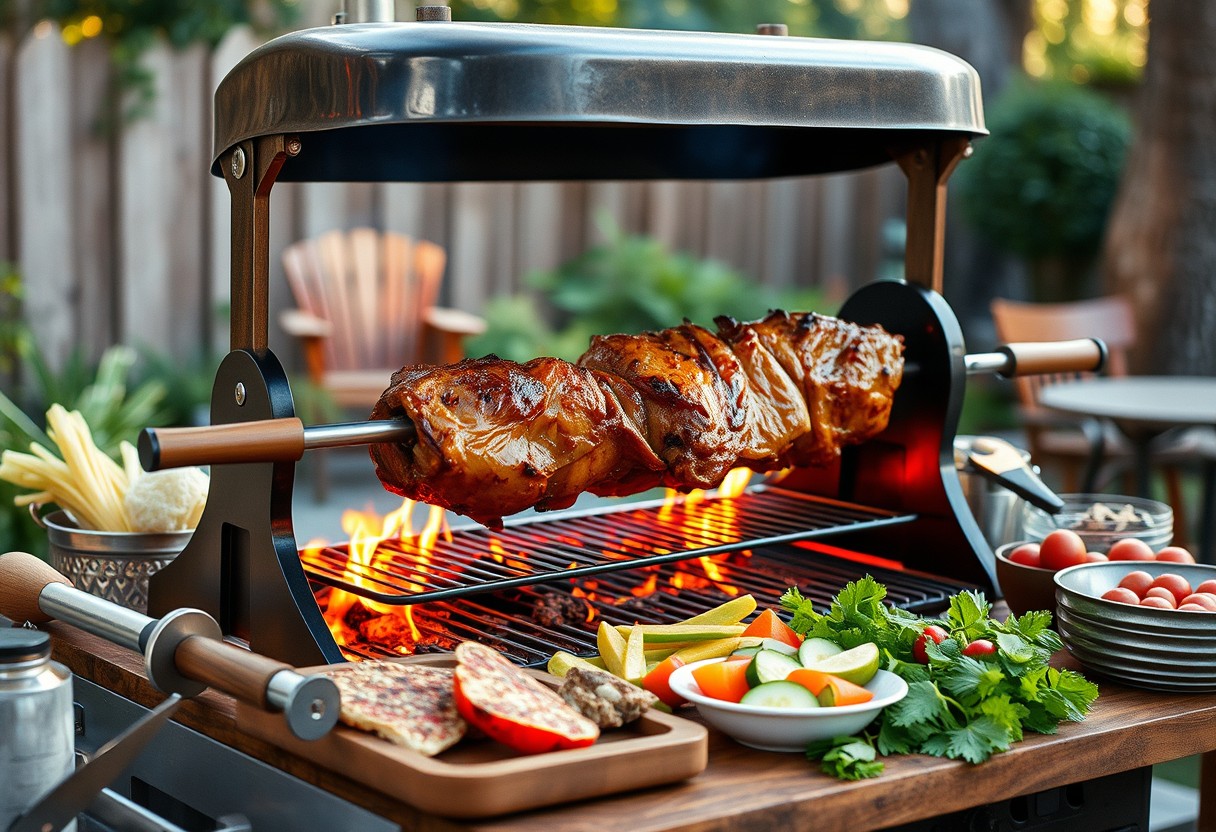

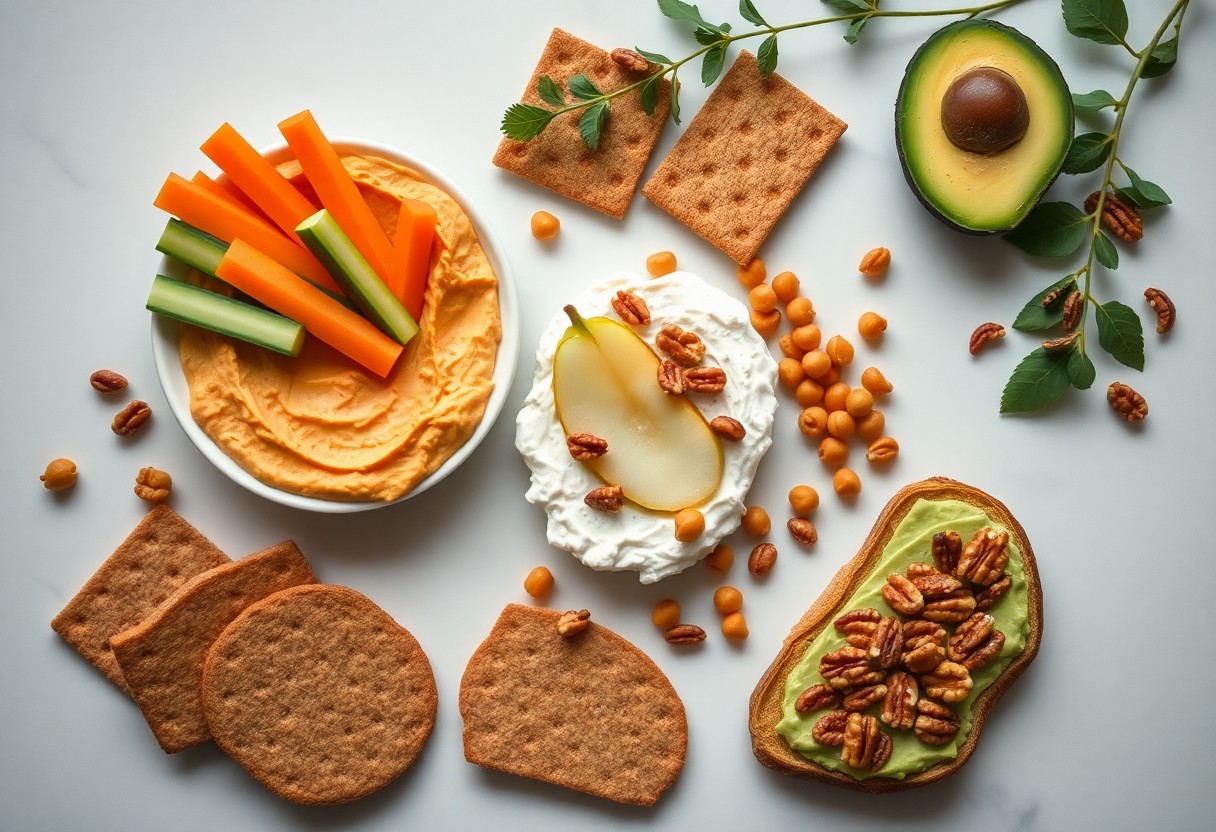
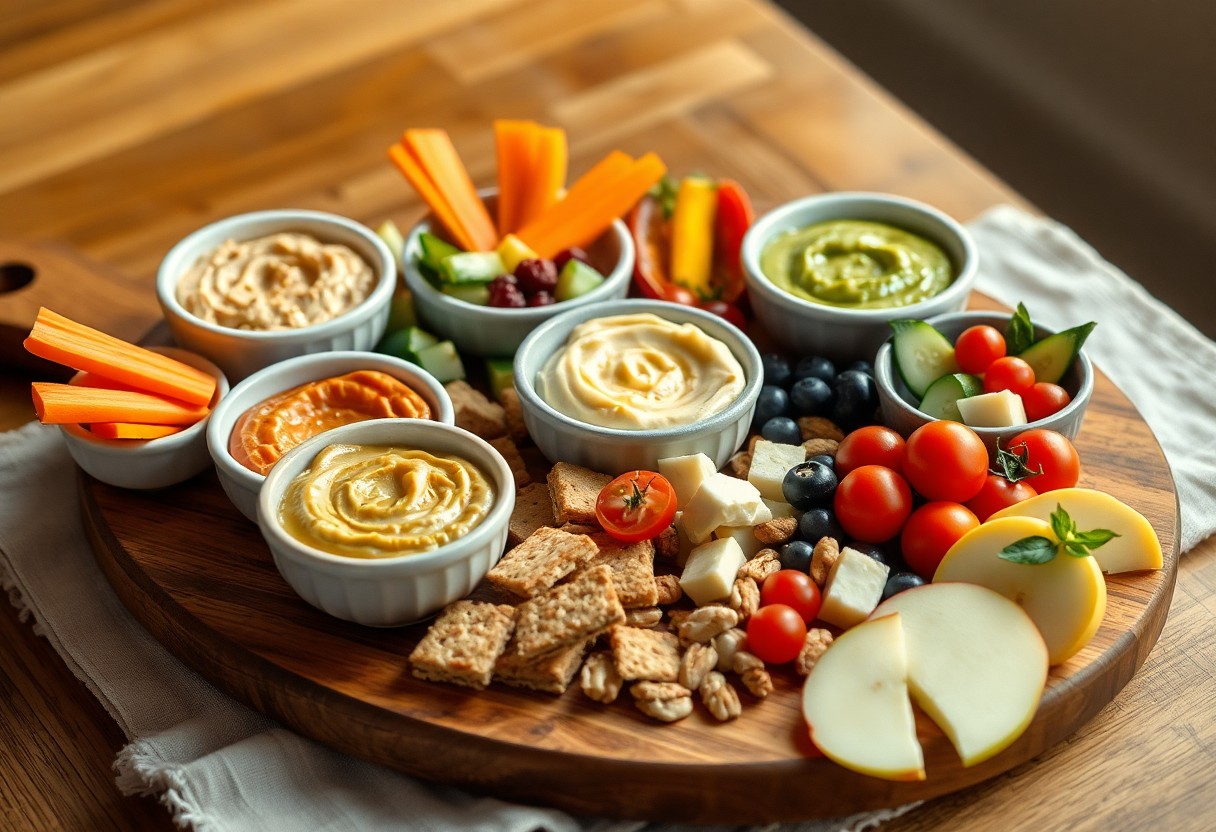
Leave a Reply